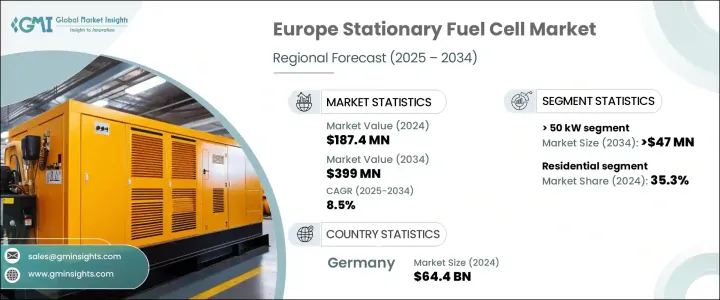PUBLISHER: Global Market Insights Inc. | PRODUCT CODE: 1716469

PUBLISHER: Global Market Insights Inc. | PRODUCT CODE: 1716469
Europe Stationary Fuel Cell Market Opportunity, Growth Drivers, Industry Trend Analysis, and Forecast 2025 - 2034
Europe Stationary Fuel Cell Market reached USD 187.4 million in 2024 and is projected to grow at a CAGR of 8.5% between 2025 and 2034. This steady growth is driven by a combination of favorable government policies, increasing environmental concerns, and advancements in fuel cell technology. Governments across Europe are offering tax credits, grants, and subsidies to encourage the adoption of fuel cells, making them more affordable for both consumers and businesses. Additionally, stringent emissions regulations and policies promoting renewable energy sources are accelerating market expansion. As the demand for cleaner energy solutions surges, fuel cells are emerging as a reliable alternative to conventional power sources in residential, commercial, and industrial sectors.

One of the key factors propelling market growth is the significant reduction in greenhouse gas emissions that fuel cells offer compared to fossil fuel-based power generation. European governments are prioritizing sustainable energy solutions to meet climate goals, and fuel cells align perfectly with these objectives. The push for integrating renewable energy sources into the grid further supports the adoption of stationary fuel cells. Consumers and industries are increasingly investing in these technologies to reduce carbon footprints, lower energy costs, and enhance energy efficiency. Advancements in material science and engineering have led to improvements in fuel cell durability, efficiency, and performance, making them an even more attractive solution for continuous power supply needs.
| Market Scope | |
|---|---|
| Start Year | 2024 |
| Forecast Year | 2025-2034 |
| Start Value | $187.4 Million |
| Forecast Value | $399 Million |
| CAGR | 8.5% |
The 3 kW segment is expected to witness substantial growth, reaching USD 135 billion by 2034. This expansion is largely driven by the rising adoption of micro-CHP (Combined Heat and Power) units that enhance overall system efficiency. These small-scale systems are gaining traction in residential applications, offering reliable backup power and off-grid energy solutions. With technological improvements boosting their efficiency and cost-effectiveness, their popularity is expected to grow further in the coming years.
In terms of end-use applications, the Europe stationary fuel cell market is segmented into residential, commercial, and industrial/utility sectors. The residential sector accounted for a 35.3% market share in 2024, with demand growing as fuel cell systems become more efficient and widely available. Fuel cells designed for home heating and electricity generation have seen success in other regions and are now being deployed across Europe. The development of high-performance materials and innovative configurations has enhanced system longevity and reliability, making these solutions viable for long-term residential use.
Germany is leading the way in the Europe stationary fuel cell market, generating USD 64.4 billion in 2024. The country's commitment to renewable energy and energy efficiency has created a favorable environment for the adoption of fuel cell technology. Government funding programs and financial incentives are further stimulating market growth, supporting the integration of fuel cells into homes, businesses, and industrial facilities. With ongoing advancements and favorable policies, Germany remains at the forefront of stationary fuel cell deployment in Europe.
Table of Contents
Chapter 1 Methodology & Scope
- 1.1 Research design
- 1.2 Base estimates & calculations
- 1.3 Forecast model
- 1.4 Primary research & validation
- 1.4.1 Primary sources
- 1.4.2 Data mining sources
- 1.5 Market definitions
Chapter 2 Industry Insights
- 2.1 Industry ecosystem
- 2.2 Regulatory landscape
- 2.3 Industry impact forces
- 2.3.1 Growth drivers
- 2.3.2 Industry pitfalls & challenges
- 2.4 Growth potential analysis
- 2.5 Porter's analysis
- 2.5.1 Bargaining power of suppliers
- 2.5.2 Bargaining power of buyers
- 2.5.3 Threat of new entrants
- 2.5.4 Threat of substitutes
- 2.6 PESTEL analysis
Chapter 3 Competitive landscape, 2024
- 3.1 Introduction
- 3.2 Strategic dashboard
- 3.3 Innovation & technology landscape
Chapter 4 Market Size and Forecast, By Capacity, 2021 – 2034 (USD Million & MW)
- 4.1 Key trends
- 4.2 < 3 kW
- 4.3 3 kW – 10 kW
- 4.4 10 kW – 50 kW
- 4.5 > 50 kW
Chapter 5 Market Size and Forecast, By End Use, 2021 – 2034 (USD Million & MW)
- 5.1 Key trends
- 5.2 Residential
- 5.3 Commercial
- 5.4 Industry/Utility
Chapter 6 Market Size and Forecast, By Application, 2021 – 2034 (USD Million & MW)
- 6.1 Key trends
- 6.2 Prime power
- 6.3 CHP
- 6.4 Others
Chapter 7 Market Size and Forecast, By Country, 2021 – 2034 (USD Million & MW)
- 7.1 Key trends
- 7.2 Germany
- 7.3 UK
- 7.4 France
- 7.5 Italy
- 7.6 Spain
- 7.7 Austria
Chapter 8 Company Profiles
- 8.1 AFC Energy PLC
- 8.2 Ballard Power Systems
- 8.3 Bloom Energy
- 8.4 Cummins
- 8.5 Fuji Electric Europe
- 8.6 FuelCell Energy
- 8.7 NUVERA FUEL CELLS
- 8.8 Plug Power
- 8.9 SFC Energy AG
- 8.10 Siemens Energy
- 8.11 Toshiba Energy Systems and Solutions Corporation




